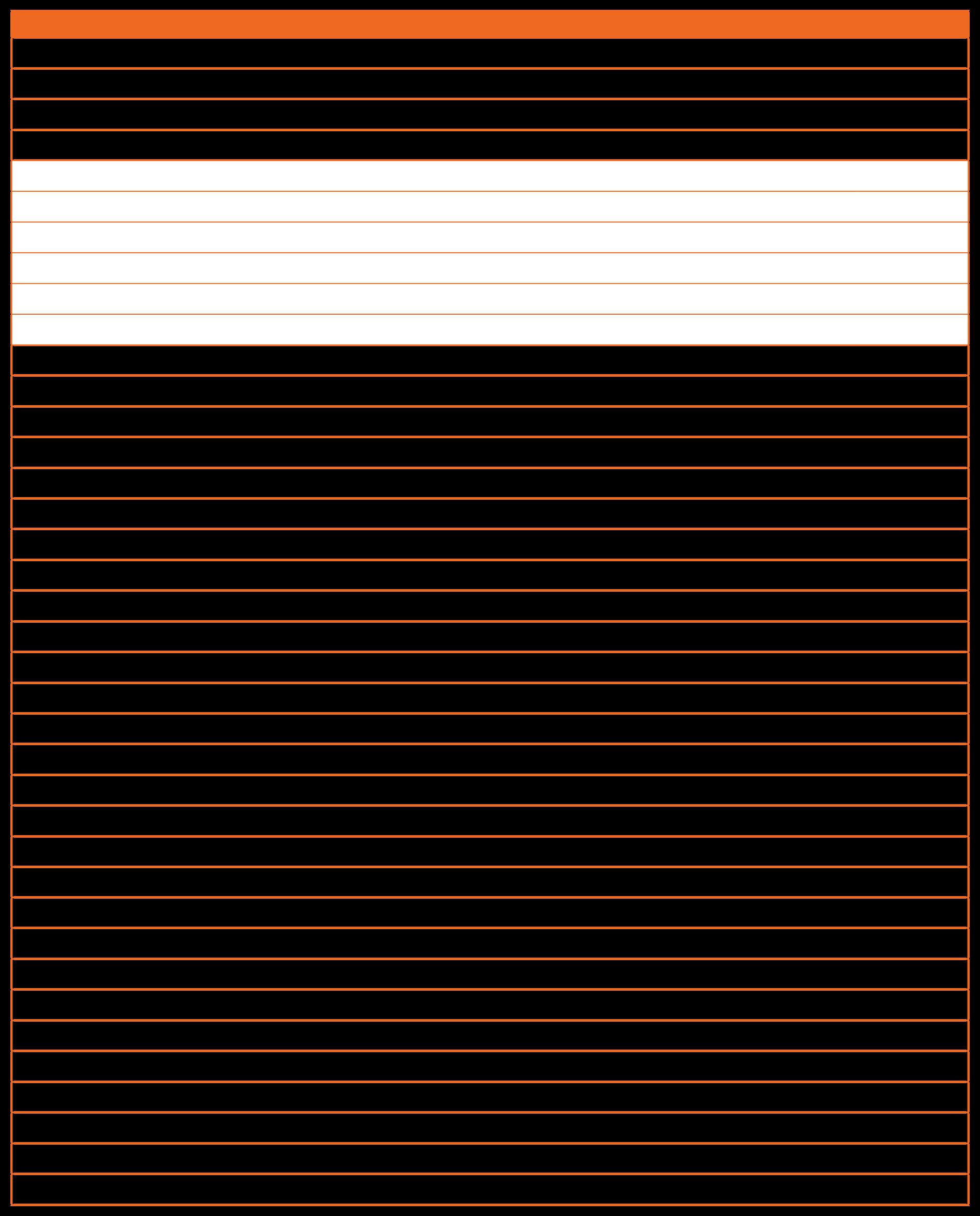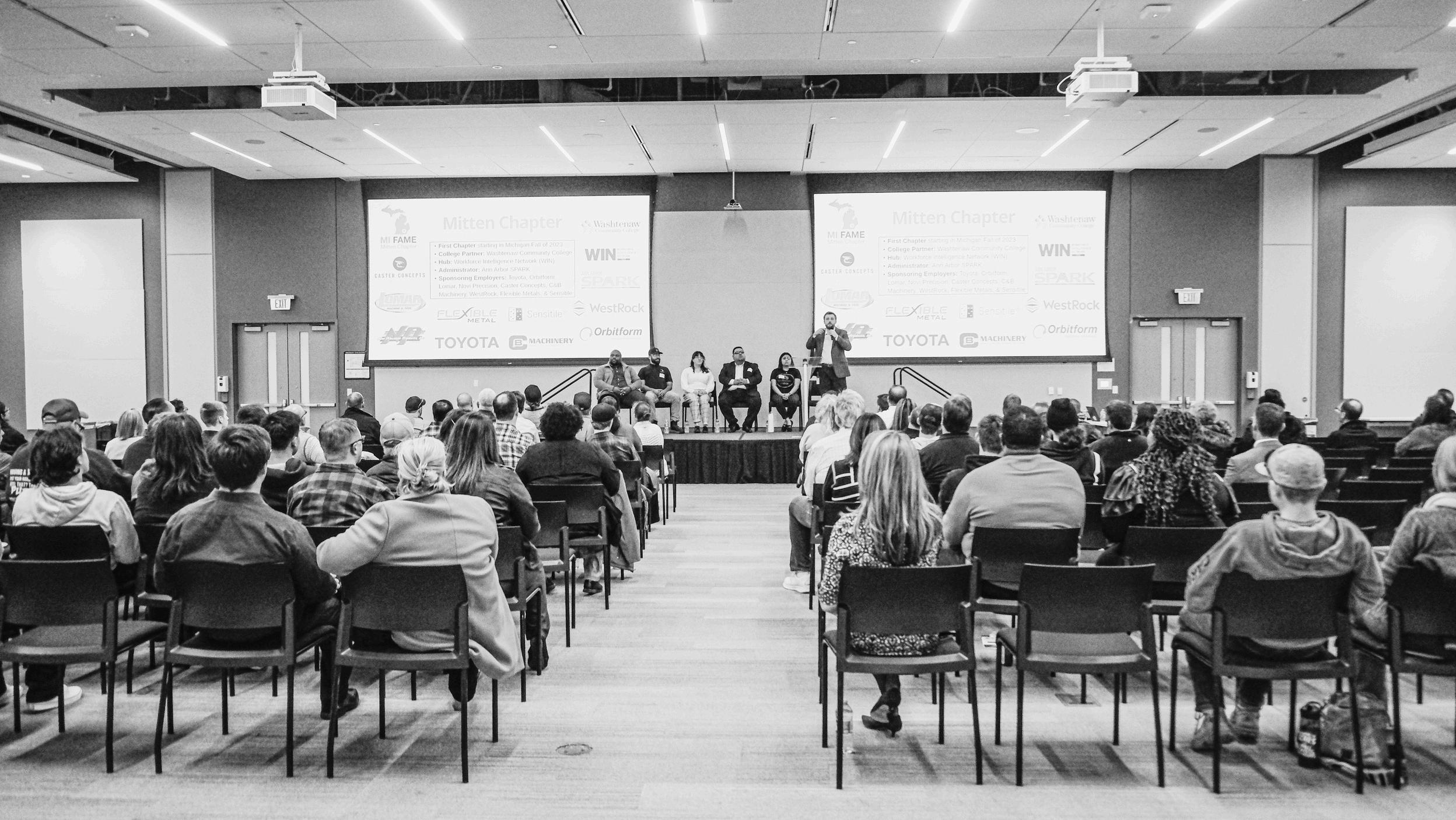











The purpose of this regional guide is to provide a multitude of helpful information, resources, and actionable steps for a career seeker/prospective apprentice, counselor/career readiness personnel, and/or employer. This guide will not only encourage the exploration of many new and traditional occupations and career pathways, but it will also reinforce that the learner and employer can take the lead in identifying and developing an opportunity for future and current resources through registered apprenticeship programs (RAP). The how-to guide provides in-depth information, the steps to take, and potential contacts for the career seeker to dive into what could be a lifelong career.
The guide is a collection of information from multiple partners working statewide in developing and establishing partnerships with employers that have or are in the process of designing and implementing a curriculum that meets the United States Department of Labor (USDOL) registered apprenticeship criteria. Youth Registered Apprenticeships (YRA) are being intertwined into existing high school programs such as Early College and Career Technical Education (CTE). Youth ages 16-18 can explore hands-on occupations while earning transferable graduation-required credits. In addition, this experiential learning opportunity prepares youth to begin their apprenticeship journey while in high school (see definition) should they choose this pathway.
For the career seeker, contact the district counselor or career counselor, and reach out to the local community college and Michigan Works! Agency to explore the options available.
For the employer, the leadership, and direct engagement of the employers is the cornerstone of a successful Registered Apprenticeship program. There are multiple partners like the Workforce Intelligence Network (WIN) Advance Michigan Center for Apprenticeship Innovation (AMCAI) team that can assist and support the organization’s talent pipeline needs to develop and launch a proven workforce solution like a RAP.
Remember that registered apprenticeships are 100% business-driven. It is up to the employer to offer and sponsor individuals in a registered apprenticeship. The career seeker must do everything possible to prepare for work and gain skills that will make them attractive to a prospective employer.


Template Questions for Career
Community College | University Programs
Other Sponsors | Support & Wrap-Around Services
High-Demand Registered Apprenticeship Occupations
Apprenticeship & Pre-Apprenticeship Myths
For the Employer:
U S Department of Labor TEN 23:23
Guide to Youth Registered Apprenticeship in Michigan
Workforce Intelligence Network (WIN) Advance Center for Apprenticeship Innovation
RAP Michigan Dashboard | Apprenticeship by State Michigan Apprenticeship Readiness Certificate (MARC)

Apprenticeship: A position as an apprentice; an arrangement in which someone learns an art, trade, or job under a skilled mentor. Apprenticeship Definition & Meaning - Merriam-Webster
Apprenticeship Training Representative (ATR): Provides technical assistance and support to Registered Apprenticeship program sponsors that administer Registered Apprenticeship Programs. An ATR can assist organizations interested in developing and maintaining Registered Apprenticeship Programs that meet national standards for quality, equity and inclusion.
Apprenticeship Success Coordinator (ASC): Promotes and facilitates access to available resources, including Intermediary and apprentice services, funding resources and helping to ensure employers can effectively register, launch, and report on program progress leading to program completion.
Career Technical Education (CTE): CTE is the practice of teaching specific career skills to students in middle and high school as well as post-secondary institutions. CTE can be a bridge between classroom learning and application in the workplace. High quality CTE programming should include employer partnerships and engagement to ensure curriculum and programming are integrating new technologies and resources. What Is Career & Technical Education (CTE)?
Pre-Apprenticeship: A program or set of strategies that prepares individuals to enter and successfully complete a Registered Apprenticeship Program (RAP). Elements of a Quality Pre-apprenticeship program may be found at Explore Pre-Apprenticeship | Apprenticeship.gov A Pre-apprenticeship program may be utilized by individuals of any age to meet the entry requirements for RAP.
Registered Apprenticeship Program (RAP): RAP’s are an industry-driven, high-quality career pathway where employers may develop and prepare for the future workforce, and individuals will obtain paid work experience with a mentor, receive progressive wage increases, classroom instruction, and a transferable industry recognized credential. Registered Apprenticeship Program | Apprenticeship.gov
Youth Apprenticeship: Another model of work-based learning that is structured as a registered apprenticeship and targeted to high school, community college, dual enrollment or early middle college students. Youth apprenticeship typically begins in 11 or 12 grade with a minimum age of 16 and covers the required skills and knowledge development over an average three-year period or another established period of time based upon the occupation or career that is chosen.
DOL_IndFactsheet_Youth_043024.pdf th th

Job Shadowing: Job Shadowing allows an individual to follow someone at their place of work to gain an understanding of a typical day in the role. It is an efficient way to learn more about a career, build a network, and add to a resume. Job shadow 101
Internship: Short term opportunities to gain entry level work experience internships provide hands on learning opportunities from experienced rich individuals/professionals on the job. Interns tend to be assigned to projects or specific outcomes to ensure skills and knowledge gain opportunities. Some internships are a required part of training such as medical or legal occupations. Otherwise, students may need to navigate the hiring process for high demand internships in a variety of fields. What Is An Internship? Everything You Should Know – Forbes Advisor
Work-based Learning (WBL): WBL is an educational strategy that provides students with real-life work experiences where they may apply academy and technical skills which provide an opportunity to develop employability. WBL bridges the gap between classroom learning to practical application in the workplace. WBL learning strategies may include internships, job shadowing, industry field trips, cooperative education, or service-learning opportunities. What Is Work-Based Learning? Definition, Examples, and How to Start - Forage
Required Technical Instruction (RTI): RTI is one component of apprenticeship programs and refers to the classroom and/or lab learning experiences of apprentices. Hours spent in the classroom are customized to enhance the On-the-Job-Training (OJT) component of apprenticeships and may be offered in-house or outside the organization. Organizations like Workforce Intelligence Network (WIN) may serve as an intermediary for employers to ensure the alignment of RTI and related curriculum for the registered apprenticeship or work-based learning. For more information on the Tools for Apprenticeship go to ETA | U.S. Department of Labor
U.S. Department of Labor (USDOL): The USDOL is the federal agency that oversees labor laws, workplace safety, unemployment benefits, and other work-related issues. Resources and general information may be found here: Home | U.S. Department of Labor. The USDOL provides several representatives to provide technical assistance and support as well as cultivation of strategic partnerships.
Fair Labor Standards Act (FLSA): Established minimum wages, overtime pay, recordkeeping and youth employment standards. The federal minimum wage is $7.25 per hour effective July 24, 2009. Many states have minimum wage laws. Wages and the Fair Labor Standards Act | U.S. Department of Labor



Registered apprenticeships are complex and require guidance and support from intermediary standards holders, counselors, career planners, apprenticeship coordinators, and business service representatives with connections to employers. Resources to support career pathway and educational development planning are important for secondary and postsecondary students. The Workforce Intelligence Network (WIN) provides annual and quarterly labor market reports, career profiles, workforce studies, and the Michigan Workforce Career and Resource Guide, which contains education and workforce contact information and career profiles with career pathway models for 25 high-demand occupations. These reports and studies can be accessed at winintelligence.org
From the evolution of the ‘Air Highway’ through the Federal Aviation Administration (FAA), energy alternatives, and the increased demand for skilled trades such as HVAC, Electricians, Welders, and Plumbers, all have unique occupational pathways. Real-time job posting information, as provided in WIN Labor Market Reports, demonstrates that employers are seeking soft skills such as strong written and oral communication skills, problem-solving and critical thinking ability and individuals with these skills have a competitive advantage and greater career pathway navigation.
It is important for career seekers to:
Network among colleagues, conferences, webinars, etc. to understand and invite experts (or read) to school, etc.
Talk with family and friends to learn more about new emerging occupations/career journeys
Understand the support and resource opportunities and learn about work-based experiences to supplement a learner’s soft skills and technical knowledge
Attend career fairs and open houses hosted by local colleges, community groups or employers
Career professionals have access to several resources including Career One Stop. This robust webbased tool may be used to explore occupational career pathways, wage and hiring demand information. Career seekers can also discover which educational institutions provide training for relevant occupations and industry certifications.
A key resource is a local Michigan Works! Agencies that provide assistance and funding to employers and career seekers for pre-apprenticeships, registered apprenticeship programs, and occupational training, depending on what their respective workforce or training needs may be. The Express Interest Instructions | Apprenticeship.gov will connect employers and educators to an apprenticeship representative contact.
Apprenticeship/Pre-Apprenticeship Literacy Statement/Expectation: While apprenticeships provide a foundation for career and personal development opportunities, it is important to note that prospective apprentices understand that literacy in reading and mathematics is critical. The Appendix includes resources for these foundational competencies.

Visit & Connect with CTE & Career
Understand the components of work-based learning and apprenticeship
Conduct self-driven occupational exploration
Explore What opportunities are available and what organizations exist to support the learner
Guide | Support Student, parent career exploration (see the Appendix for samples)
Readiness Staff
Attend Career Fairs as early as middle school, students should be encouraged to engage in hands-on learning opportunities
Begin EARLY most programs start the Junior year of high school.
Post-secondary Adult Learners & career seekers should also explore the many preapprenticeship, apprenticeship programs, summer camps and immersion programs at local community colleges or community agencies
Meet with School/Career Staff at a local training provider college or community college, or high school to discuss options to earn credit, work-based learning (internships, job shadowing, etc )
Research & Plan
Community college and school districts workbased learning opportunities vary in training length, industry credentials, availability and delivery format
Funding & Budget
Work with a mentor or counselor to learn about available training funds Many apprenticeships/pr e-apprenticeships are funded through Michigan Works! Agencies Understand how to apply for Financial Aid, grants, scholarships and loans (subsidized/ unsubsidized) and grant requirements It is recommended to create a budget
High School Graduates
Connect with a local Michigan Works! Agency to provide guidance on individual interests, connections with employment and training opportunities, apprenticeshi ps, and MORE

There are several resources and ways for career seekers to explore apprenticeships and work-based learning opportunities. Peer engagement, career fairs or in their inner circle of family and friends may also provide insight, job shadowing, etc. as well as past work or service experiences. Apprenticeship USA, State of Michigan CTE and Michigan Department of Education and Office of CTE websites are a wealth of information (websites are included in the Appendix). Check out this resource: Earn While You Learn Today.
BENEFITS OF APPRENTICESHIPS:
and Technical Skill Development Job satisfaction and employee retention
Network & Contacts
TYPICAL PRE-APPRENTICESHIP CANDIDATES: UNDERSTANDING APPRENTICESHIP
School
&
Seekers & Adult Learners
a National Credential
The role of the Training Provider is to deliver RTI in the form of credit or non-credit curriculum. Apprenticeships are highly flexible and RTI can include employer (internal) classroom training and courses from a local community college or similar accredited training provider. The Apprentice may earn a nationally recognized credential with transferable skills across occupations and an associate’s degree or certification. Technological advancement increases the need for lifelong learning which can lead to stackable credentials. The U.S. Department of Labor (USDOL) certifies a registered apprenticeship program (RAP) for the employer. Earn While You Learn (education & income) Work-based learning
There are four (4) required partners for a registered apprenticeship program: 1) Employer, 2) Training Provider, 3) Apprentice, 4) U.S. Department of Labor. The primary partner for any apprenticeship is the Employer which defines related technical instruction (RTI), learning outcomes, on-the-job (OJT) learning and skills and competencies.

Apprenticeship opportunities may be found in many industries and include some of the following examples:
Health Care: Surgical Technicians, Radiology Technicians, CNAs, LPN and RN
Advanced Manufacturing / Skilled Trades: CNC Machinists, Mechatronic Techs, Robotic Engineers, Electrician, Plumber, Drafter-Tool Design, Field Service Engineer
Service Occupations: Baker Pastry Cook, Direct Support Specialist, Housekeeper General
Insurance Associate
Education: Early Childhood Educator, Teacher Aide, K-12 Teacher, And more!
The apprenticeship.gov website includes videos, fact sheets and more: Career Seekers | Apprenticeship.gov
High School, beginning with freshmen, may receive guidance from school counselors and teachers about apprenticeships. In Michigan, registered apprenticeship opportunities are incorporated in Early Middle College programs of study: Early Middle College High School Opportunities
CASE STUDIES AND SUCCESS STORIES:
FAME USA – Mitten Chapter: Next generation workforce
Student lands dream opportunity after completing OCC’s short-term training program
DEMYSTIFYING THE APPRENTICESHIP PROCESS AND COMMUNICATION
Below are sample scripts for the Career Seeker along with an example of how to incorporate a workbased learning experience into a resume.
a) Sample email to an Apprenticeship Coordinator at a local Michigan Works! Agency:
Hello, (Coordinator’s name),
I am currently a student or recent graduate at/from (training provider/college) in the (program/certification) and interested in a registered apprenticeship program in (occupational / career area) I would like help in connecting to potential employers
I may be contacted by (phone / email) between the hours of (identify best time/day). I look forward to hearing from your office.
Sincerely, (Your name)

b) Sample email to current employer about being a sponsor for a registered apprenticeship:
Mr./Miss/Mrs. (Direct Supervisor),
I am currently a (your position) in the (department/group) and would like to inquire whether (name of employer) would be interested in being a sponsor of a registered apprenticeship program. The mutual benefits for (name of your employer) and employees such as myself may include the availability of financial resources and earning industry credentials while employed, advancing my skills and knowledge for the company.
There are resources and experts who can support employers in establishing the apprenticeship. In Southeast Michigan: MI Apprenticeship or the local Michigan Works! Agencies: Apprenticeship Works! MichiganWorks! Association Your consideration is appreciated, and I look forward to exploring the registered apprenticeship opportunities here at (name of company)
Sincerely, (Your name)
c) Incorporating work-based learning on the resume:
Apprenticeships are valuable learning experiences validating hands-on training and industry-specific skills. The job seeker will want to attractively add it to a resume. What is the best way to do this?
Here is a guide:
Apprenticeship Title: be sure to include the company
Duration: start/end dates
Job Title: include relevant duties and responsibilities
Skills Developed: list skills, and knowledge gained, including relevant certifications
Example:
Apprentice Electrician, Holmes Electrical Contractors (June 2022 – 2025)
Apprentice Electrician, Two years
Skills:
Installation and maintenance of electrical systems
Use of electrical testing equipment
Service and test electric vehicle charging station
Understand electrical safety protocols
Achievements:
Completed 100% past rate on electrical safety training
Received certificate of completion for a registered apprenticeship program
Find your high school, Michigan Works! Agency, and an education and training provider at MIApprenticeship.org



No matter where the organization is on the continuum of researching, designing, or launching an apprenticeship program, understanding the basic requirements and resources to develop a quality registered apprenticeship program are critical. Making a list of questions and reasons for an apprenticeship program is an excellent place to begin.
This guide is a comprehensive resource to assist an organization with constructing a framework that is customizable and flexible in meeting occupational and talent demands.
There are several employer benefits for Pre-Apprenticeship programs:
1.Save time and resources,
2.Provides a pre-screened prospective employee,
3.Provides ready-to-work employees who have been trained in specific skills the employer needs.
Additional benefits for RAP’s:
Develop and grow a highly skilled workforce
Reduce turnover and foster loyalty among employees
Create customized, flexible training solutions to meet unique needs
Institutional knowledge transfer and management is of great benefit to organizations with retirement-eligible employees
Access to resources
Talent attraction of veterans, unemployed, underemployed, and disadvantaged populations
Productivity needs
While we have defined pre-apprenticeships, a quality program that benefits the participant requires a strong foundation of employer involvement to ensure valuable outcomes.
The USDOL notes the following five (5) elements that make a pre-apprenticeship high quality framework.
4.Partnership with registered apprenticeship program (RAP) sponsors
5.Sustainability through partnership
6.Meaningful training combined with hands-on experience replicating a workplace that does not displace paid employees
7.Access to career and supportive services (wrap around)
8.Strategies that increase RAP opportunities for underrepresented or underserved populations facing significant barriers to employment in the RAP labor force
A closer look at these elements:

1 Partnership with an established RAP Sponsor involves developing a written plan with RTI training goals and defined skills that enable pre-apprentices or certification completers to become accepted into a registered apprenticeship program. The employer also has the responsibility to provide mentorship, supervision, and direct assistance to participants in the program.
2 Sustainability via Partnership should encompass a collective effort to promote RAP and develop a skilled workforce. Partners may include labor organizations, workforce systems, educational providers, as well as community and faith-based organizations.
3.Hands-On Training: While the apprenticeship does not support a paid employer, the experience is more effective with simulated industry and occupational conditions, and appropriate lab or workplace scenarios that allow the individual to understand, engage, and participate as appropriate in the occupational landscape. Virtual reality is becoming a fast-growing tool for occupational exploration.
4 Career and Support Services: Whether an adult learner navigating a new occupation or a young person having access to potential support services to ensure full participation, funding may be available to help alleviate barriers such as childcare or transportation to the work site location. Checking with local job services, schools, etc. may be part of the partnership as well.
5 Service Underrepresented or Underserved: Recruitment and partnership strategies should align to ensure access and availability to a broad range of populations including those who may be unaware or have fewer resources available. Engaging community and faith-based organizations in the outreach as well as presentation of opportunities are encouraged.
Understanding the primary elements of a quality pre-apprenticeship is the design that prepares preapprentices for an entry-level RAP. Recommended outlines and design elements are available at: Explore Pre-Apprenticeship | Apprenticeship.gov
At a minimum, three (3) of these characteristics should be included:
1 Approved curriculum: Similar to a registered apprenticeship program, the pre-apprenticeship program should be designed to align with employer skills requirements and competencies that may lead to a related RAP.
2.Hands-on training: Volunteer opportunities that do not displace paid employees,
3.Direct Entry: Sponsor agreements provide qualified participants to enter/qualify for a RAP.
Supportive services, outreach, and recruitment efforts that ensure inclusive and underrepresented populations and sustainable collaborative working to promote RAPs.

An initial decision for an employer to serve as the direct apprenticeship sponsor or to select an intermediary to develop and manage RAPs in compliance with USDOL apprenticeship standards.
The table below examines the fundamental benefits and challenges serving as the direct sponsor or working with an intermediary to manage all apprenticeship activities:
Intermediary manages a database of apprentice and journey person RTI and OJT data entry and documentation and ensures completeness of records, and obtain missing data and documentation.
Intermediary works with USDOL Office of Apprenticeship on behalf of the employer to approve new RAP standards and to obtain certification for apprentice completers
Intermediary monitors activity, documents and evaluates completion of records for submissions.
Intermediary is subject to audit and confirms to 2CFR200 grant management guidelines, including record retention.
Employer manages the timeline and paperwork to develop new RAPs and complete Appendix A RTI/OJT requirements by comprehensively documenting, tracking, and reporting data to earn a USDOL national credential for apprentices completing RAP programs
Employer works directly with the USDOL Office of Apprenticeship in Michigan
Employer monitors all the documentation and paperwork deadlines.
Employer is audited by USDOL, as requested.
Being a direct sponsor with the USDOL is certainly an option for an employer should they have proprietary processes and/or equipment. Considering the benefits above, an intermediary may be a good fit for the organization to maximize the resources available. The management and monitoring to ensure the program meets expectations and achieves desired learning outcomes can be a winwin for everyone.
In addition, the intermediary will keep the employer representative(s) informed of USDOL updates, opportunities for funding and provide any regional and local information in real time.

The WIN Advance Michigan Center for Apprenticeship Innovation (AMCAI) Intermediary team has a proven record of support and provides step-by-step support along with the development, launch, and ongoing support of all apprentices. miapprenticeship.org
Below is an eight (8) step visual aid that describes each step in managing new and/or existing apprenticeship programs.



Explore the fact sheet on quality pre-apprenticeship for Federal Partners to learn more about the five core characteristics and success stories linked to quality programs. Look to your state and intermediaries in the region to help guide you in establishing a pre-apprenticeship program.
Fact Sheet on Quality Pre-Apprenticeship for Federal Partners
A. Advance Michigan Center for Apprenticeship Innovation (AMCAI): Offers no-cost tools and resources and has technical apprenticeship experts with more than 50 years of combined experience to provide support and resources to launch pre-apprenticeship and/or RAPs.
B Michigan Works! Agencies: Business Services Representatives (BSR) work directly with employers and can connect job seekers to apprenticeship opportunities, and braided funding assistance. Some Michigan Works! Agencies are USDOL approved Intermediary Standards Holders.
C. Michigan Department of Labor and Economic Opportunity (LEO): Statewide registered apprenticeships information.
D. Apprenticeship.gov: Provides multiple resources related to pre-apprenticeship tools, starting a program, and a partner locator tool. Partner Finder | Apprenticeship.gov


NOTE: At the time of publication some websites may have changed. We apologize for any possible broken or non-functional links.
As shown below, there are many pre-apprenticeship programs throughout Michigan to explore. From local community colleges to community-based organizations (CBO) there are several opportunities to choose from Remember to check with Michigan Works! Agencies for the latest programs and services that may be available to help guide career exploration.
There are several documents accessible online from the Michigan Department of Education (MDE), including the Michigan Career Development Model which provides age-appropriate career awareness, exploration, and career preparation by grade. This is a fantastic resource for everyone, from parents to employers, helping guide curriculum and program development.
To further inform parents and professionals, the MDE recently updated the Work-Based Learning manual, which describes the work-based learning model and introduces terms that provide a foundation of quality work-based learning and approved CTE curriculum. The image below is from the manual
The term WORK-BASED Learning means sustained interactions with employers or community professionals in real workplace settings, to the extent practicable, or simulated environments at an educational institution that fosters in-depth, first-hand engagement with the tasks required of a given career field, that are aligned to curriculum, instruction, and standards
Teacher-led connection to business and indsutry that introduce students to various aspects of or types of careers.
Sustained partnership led by industry professionals in which students gain competency and develop mastery of occupation-specific tasks and skills.
Student-led or student-initiated activities intended to define a student’s area of interest that are aligned with academic technical, and employment skills
Employers and educators collaborate to increase student engagement with industry mentors and develop employment and transferable skills.
There are countless CTE programs across the state of Michigan and new programs being explored and/or implemented every year Here is a link to the CTE facts brochure and at-a-Glance Resources
Alpena Public Schools: 2373 Gordon Rd, Alpena, MI 49707, 989.348.5200
Career & Technical Education | Alpena Public Schools

Copper Country IDS Career & Technical Education: 110 E Quincy St. Hancock, MI 49930, 906.482.4250
Eastern Upper Peninsula IDS: 315 Armory Place, Sault Ste. Marie, MI 49783, 906.632.3373
Career and Technical Education - Eastern Upper Peninsula ISD
Genesse Intermediate School District: 2413 W. Maple Ave, Flint, MI 48507, 810.591.4098
Pre-Apprenticeship - Genesee Intermediate School District (geneseeisd.org)
Jackson Area Career Services: 6800 Brown Lake Road, Jackson, MI 49201, 517.768.5100,
Home - Jackson Area Career Center
Kalamazoo Public Schools: 1220 Howard Street, Kalamazoo, MI 49008, 269.337.0100,
Career Launch Kalamazoo - Kalamazoo Public Schools
Oakland Schools Technical Campuses: 2111 Pontiac Lake Rd, Waterford, MI 48328, 248.209.2000, Four locations
All CTE Programs - Oakland Schools Technical Campuses
Saginaw ISD – Career Complex: 3933 Barnard Rd, Saginaw, MI 48603, 989.399.7473
Career & Technical Education | Saginaw ISD
Sault Area High School & Career Center: 904 Marquette Ave, Sault Ste. Marie, MI 49783, 906.635.3839 x5819
Career and Technical Education - Sault Area High School & Career Center
Washtenaw ISD CTE: 1819 S. Wagner Rad, Box 1406, Ann Arbor, MI 48106, 734.436.2948
Current CTE Programs - Career Technical Education - Washtenaw ISD
Wayne-Westland – William D. Ford Career-Technical Center, 26455 Marquette, Westland, 48185, 734-419-2100
William D Ford Career-Technical Center - High Schools - Schools - WWCS Homepage

Here is a sampling of questions to ask a school administrator or college personnel when visiting and researching program options:
Does the school or school district offer CTE, early middle college programs? If so, please describe.
What dual credit options does the school offer for work-based learning opportunities? What is the completion / graduation requirements for program?
Are there paid CTE, pre-apprenticeship opportunities?
If there are youth apprenticeship programs, what are they? What challenges in program?
Is there transportation or must the individual arrange transportation? I am interested in _______________ CTE program. Is there a reciprocal relationship or instructional delivery options (virtual reality, online) to take advantage of?
Here is a sample of questions to consider: (Source: With Learners, Not For Learners: A Toolkit for Elevating Learner Voice in CTE)
Why is the career seeker interested in enrolling in a CTE program?
Describe previous experiences or training that may be relevant to being an apprenticeship. Is the career seeker familiar with the tools/equipment used in this occupation? What roadblocks, if any, might the career seeker encounter or need to address before enrolling (transportation, etc )?
Has the career seeker attended (event) that may give the student an opportunity to ask employers questions? What type of occupation/job interests the career seeker?

In partnership with employers, community colleges offer multiple opportunities for high school students as well as re-entry and adult learners in local communities. Training funds, scholarships along with pre-apprenticeships and registered apprenticeships are available to assist with upskilling, reskilling, and new/prospective employees Below is a sampling of programs across the state that may be nearby to explore and/or refer to a career seeker.
Southeast Region:
1.Henry Ford College: Power and Trades Pathways Pre-Apprenticeship: Electrical Transmission and Distribution Technology - Certificate of Achievement | HFC Catalog
2 Jackson College: Lineworker - Jackson College
3.Macomb Community College: Skilled Trade Apprenticeships: Learn & Earn! (macomb.edu)
4.Monroe Community College: MCCC Offers New Pre-Apprenticeship and Skilled Trades Readiness Program | Monroe County Community College
5.Mott Community College: Electric Lineworker Pre Apprenticeship Training Program - Workforce & Economic Development | Mott Community College
6 Oakland Community College: Pre-apprenticeship | Oakland Community College (oaklandcc edu),
7.Schoolcraft College: Program: Program: Welding: Pre-Apprenticeship Certificate - Schoolcraft College - Modern Campus Catalog™
8.Washtenaw Community College: Ironworkers Pre-Apprenticeship (WCC Programs),
9.Wayne County Community College District: Apprenticeship Wayne
Statewide:
1.Alpena Community College: Electric Line worker Pre-apprenticeship Training
2.Delta College: Apprenticeships | Delta College
3.Lansing Community College: Electric Lineworker Pre-Apprenticeship Training | Consumers Energy
4 Mid-Michigan College: Welding Pre-Apprenticeship Certificate Pathway | Mid Michigan CollegeHarrison, Mt Pleasant, MI,
5.Northern Michigan University: Apprenticeships | Career and Technical Education TAKE ACTION: Make a follow-up List!

The reality of multiple barriers to participation are not simply transportation to/from work site. Preapprenticeship opportunities being offered should consider and seek support for inclusivity and engagement by a broad reach of students Location, economics, and threading mentorship or coaching to support these initiatives are foundational for long term success.
Michigan Works! Agencies and educational partners may work hand in hand with employers to inform and possibly secure funds to address support services and/or unique needs. Learning tools such as virtual reality (VR) goggles, software, and computers may be secured through various funding streams ASK the school counselor, local MWA, or agency that may have access to supportive services and wrap-around funding. Here are multiple supporting agencies, either providing direct support or resources to reach out to during the career journey:
Apprenticeship USA: Apprenticeship.gov, (National Apprenticeship Week)
Detroit at Work: YouthBuild | Detroit at Work
Jackson Area Manufacturing Association (JAMA): Pre-Apprenticeship/ Apprenticeship
State of Michigan: Michigan Department of Labor & Economic Opportunity (LEO)
Office of CTE– Find events, instructor information, and Early Middle College and Career Development Resources. (Note: Early Middle College now includes Registered Apprenticeship program participation)
USDOL: Youth Registered Apprenticeship: Guide to Youth Registered Apprenticeship in Michigan Veterans & Apprenticeship: Hire Veterans | Apprenticeship gov
ADVANCED MANUFACTURING: Aerospace Engineer, CNC Machine Operator, Tool and Die Maker, Plastics Fabricator, Mechatronics and Mechanical Engineering Technician, Quality and Robotics Technicians, Project Management
CLEAN ENERGY: Line Maintenance, Electrician, Gas Main Fitter, Water Treatment Specialist, Substation Operator, Power-line Distribution Erector
INFRASTRUCTURE: Computer Technician, Software Developer, Cybersecurity Analyst, Web Developer/Designer
TELECOMMUNICATIONS: Telecommunications Technician, Fiber Optic and Wireless Technicians, Parts Sales, IT Generalist, Broadband Technician, Customer Service
TRANSPORTATION: Avionics Technician, Diesel Mechanic, Airframe & Powerplant Mechanic, Truck Driver, Storage & Distribution Management & MORE

(source: miapprenticeship.org)
A Registered Apprenticeship Program (RAP) is a structured process that allows employers to create a customized skilled trades training program Registered Apprenticeship is a Department of Labor/Office of Apprenticeship (DOL/OA) recognized training pathway supported by the State of Michigan, which offers employers a chance to train new talent with minimal cost investment. This concept applies to Pre-Apprenticeships. Pre-Apprenticeships span generations including adult learners, youth, and post-high school populations. Below are a few of the apprenticeship myths. The full list may be found at Myths About Registered Apprenticeship.
Internships allow an individual to gain work experience, and there is no assurance of employment A RAP always provides employment, is long-term, includes a progressive wage scale, and leads to a career with national credentials.
There is no cost to create and set up RA programs! U S employers can use apprenticeships to gain a pipeline of site-specific, skilled, and productive workers Nationally, employers see a return on investment of about $1.47 for every $1 invested. Additionally, there are many workforce development grants available to employers to assist with the training cost.
Registered apprenticeships are not just for union shops, in fact, there are more non-union companies than union companies registered nationally
The reality is that most apprentices stay with their employer throughout the course of their apprenticeship and beyond. They develop a sense of loyalty to an employer who invested in their training.

While there are occupations that are not apprenticeable due to the nature of and experience demands due to safety and liability concerns, today there are many ways for young people and adult learners in career transition may be exposed to and gain insight into a particular occupation. Job Shadowing and internships are an introductory way to expose prospective talent to occupations as well as virtual reality tools that may provide insight into a typical day on a work site Site tours, in-office visits, and face-to-face interviews all provide individuals to ask questions and learn from those on the front line of an occupation.
There may be shared costs for liability should a prospective pre-apprentice student come from a school district CTE program This may be discussed in advance with the administration as the preapprenticeship program is developed

A USDOL TEN 23:23 - TEN 23-23 | U S Department of Labor

B Youth Registered Apprenticeship: Guide to Youth Registered Apprenticeship in Michigan
C. Workforce Intelligence Network: MI Apprenticeship
D. Registered Apprenticeship Michigan Dashboard | Apprenticeship by State
E. Michigan Apprenticeship Readiness Certificate (MARC): in pilot stage | LEO - Michigan Apprenticeship Readiness Certificates (MARC)
Consumer Energy & Provider Partners: consumersenergy.com/work-with-us/careers/school-towork-programs at Grant Rapids Community College, Jackson College, Alpena Community College, Lansing Community College, and Mott Community College
Zaman International - zamaninternational org
Literacy Resources:
A list of reading and literacy programs and resources may be found for the state of Michigan here:
K-12 Reading and Literacy Programs and Resources
Beyond Basics – Literacy is for Everyone– both online and in person instruction
Flint Kids Read – The Flint & Genesee County Literacy Network
Grizzly Learning Camp - Academics - Ypsilanti Community Schools
GSRP-Great Start Readiness Program - Delta Schoolcraft Intermediate School District
Advanced Michigan Center for Apprenticeship Innovation (AMCAI), Workforce Intelligence Network, MI
Brad Minton, LPC, CCC, CPRW, Post secondary Success Navigator, mintonb@resa net
Jackson Area Manufacturers Association: Home - Jackson Area Manufacturers Association
State of Michigan Labor and Economic Opportunity Registered Apprenticeship
